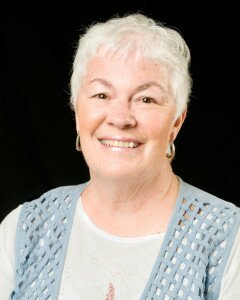Then & Now
By Judy Salamacha
 Storytelling predates writing. Inherent in every culture, stories have been used to teach moral values, maintain family traditions and preserve cultural concepts.
Storytelling predates writing. Inherent in every culture, stories have been used to teach moral values, maintain family traditions and preserve cultural concepts.
Think about it. Most of us now read books containing fables and folktales that used to be passed along by bards, Native American storytellers or the family historian. Is anyone keeping the art of storytelling alive today?
Kirk Henning is and will be as long as he is physically and mentally capable of spinning yarns for anyone who will listen.
“I always performed in school — in band and as a ventriloquist,” said Henning, an environmental scientist by profession and a professional storyteller by avocation. His Central Coast storytelling journey began when wife Patty volunteered him for pre-school story time at Coalesce Book Store in Morro Bay.
“After about a year,” he said, “we thought it would be fun to share stories with families around a campfire on Cayucos Beach.”
For 16 years, Kirk and Patty were able to secure the fire pit permits for “Stories ‘Round the Fire” events in summertime. The first session attracted around 15 people. Eventually 80 to 100 locals and tourists participated.
“I had college students attend saying it was part of their family vacation tradition,” he said. Besides Henning’s animated interpretations of his favorite stories, their entire family — including two now-adult, now-trained storytelling daughters — encouraged audience involvement, invited guest storytellers, shared music, and roasted marshmallows. Donations offset the permit costs and marshmallows.
“There is real power in storytelling,” Henning said. “Folktales, parables all have an underlying message that can teach morals and ethics. Some stories I tell over and over again. Repetition confirms those cultural messages.”
Humorous or scary, Henning believes storytelling can develop a child’s courage, diligence and other virtues. “Children interpret stories differently than their parents,” he explained. “They love to be frightened.” Children will suspend reality and empathize when the hero vanquishes the villain, Dorothy dissolves the Wicked Witch with water, or the slow but steady turtle wins the race.
“‘Abiyoyo’ is a favorite David and Goliath story,” said Henning. Musician Pete Seeger popularized the story-song about a boy who plays the ukulele, and his magician father who are not well accepted in their African village until they save the day by making a fierce monster dance and disappear.
After Stories ‘Round the Fire saw its last sunset, Henning became a regular guest storyteller for groups, schools and events such as the Stone Soup Music Festival and Street Faire in Grover Beach. The Hennings co-produced the Pacific Storytelling Festival (1995-2000) at Montaña de Oro State Park, attracting nationally renowned storytellers to perform and camp out, until it became two additional fulltime jobs.
Henning’s other moonlighting adventures have been teaching storytelling at Cal Poly and directing high school and community theater productions. He was drama coach at Coast Union High School in Cambria for five years, directing such productions as “Oklahoma!” and “The Music Man.”
Henning’s latest passion is SLOLio, “a gathering of true stories…” told by local storytellers based on an ever-changing theme and meeting monthly at Linnaea’s Café in Downtown SLO. The theme is revealed on the website (see: www.slolio.org) on the third Wednesday of the month, so storytellers can prepare an 8-10 minute story based on true experiences.
“We have a core group of regulars and drop-ins or vagabonds, as I like to call them,” he said, “that are always welcome to participate or listen. The skill level is amazing. I’m always surprised by the different takes on the theme.”
Besides the posted theme, like “In the Fog,” the website has audio recordings of stories and tips for good storytelling. He discourages “political or religious propagandizing, rants, raves, and stream of consciousness epics.” Some simple tips include, “Let your imagination go for a ride. Let the theme stew a bit, you’ll be surprised what can emerge from the depths. You don’t need to memorize the story. Practice helps. Embrace mistakes. Take a breath, absorb the supportive energy of the audience and begin.”
Indeed, storytelling is alive and active in San Luis Obispo! SLOLio’s 43rd “gathering” is set for 7 p.m. Wednesday, Feb. 18. Linnaea’s Café is at 1110 Garden St. The theme to “stew a bit” before telling your story is “From the Ashes.”
Judy Salamacha’s “Then & Now” column is special to Tolosa Press. Email her at: [email protected] or call 801-1422.

